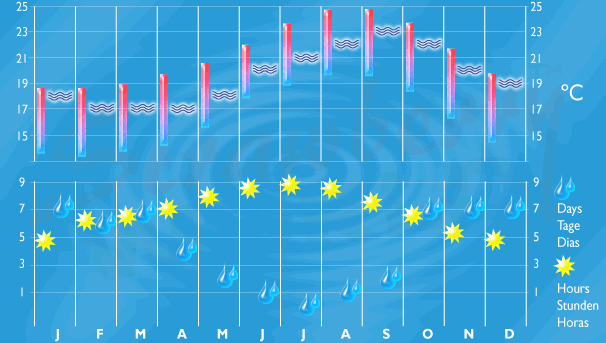Weather in Madeira
When you arrive on Madeira, take a good look around. The pleasant soothing colours invading the senses are the luxurious tones of rich green set against an azure sea - the hall mark of the subtropics. They also tell of rain. This isn't to say that it rains all the time, or even most of the time. But it does rain some of the time.
Now that the shock has been administered lets start again. Most
people who live here find Madeira has just about the most perfect climate in the
world. It is never too hot (temperatures can get up to around 33 C when the
Leste wind blows for a few days every year) averaging maximums of 24 C during
the summers months (July through to October) and minimum's of 17 C. During the
winter average temperatures drop by approximately 4 C.
The island is full of little micro climates. The bay of Funchal, protected as it
is by the highest peaks enjoys the best of sunshine except in the months of
February and March when an enveloping cloud known as the 'capacete' (the
helmet), blocks out the sunlight. Further down the west coast at Ponta do Sol
and Calheta, backed as they are by the lower hills of the Paul da Serra, the sun
shines brighter during these months, but they are less protected from the sea
winds.

The prevailing wind is the North Easterly Trade that gathers off the Portuguese
coast and runs down to the Cape Verde Islands. It brings moisture and large sea
swells to the north coast, and often, particularly in the morning, adversely
effects the weather on the eastern end of the island between Canišal and Canišo.
However in a westerly wind these areas can be surprisingly dry and sunny whereas
the south and west coasts are duly soaked.
So now back to where we started. Madeira has lots of sun and a fair bit of rain.
If you want undiluted sun (plus the tranquil features of a lunar landscape) then
anything from Cairo to Lanzarotte should just about suit. Those with more mature
tastes should opt for paradise.
